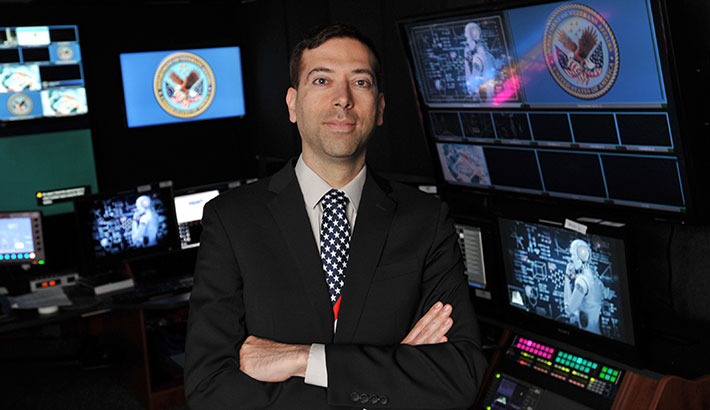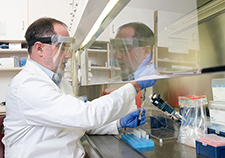Office of Research & Development |
 |


Dr. Gil Alterovitz is VA’s first director of artificial intelligence. (Photo by Robert Turtil)
July 10, 2019
By Mitch Mirkin
VA Research Communications
"It's about establishing a human-AI collaborative environment."
When Facebook suggests a new friend for you, or Gmail shows you ads based on your email content, or Alexa or Siri understands your verbal command to do some chore in the house, that’s artificial intelligence at work.
Or, for a more dramatic example, think of driverless cars that read traffic and make lightning-fast decisions to stay on course and avoid accidents.
Basically, artificial intelligence (AI) means using computers to simulate human thinking. Computers will never be able to fully replicate the human mind in all its amazing nuance, speed, and complexity—at least most people hope not!—but scientists have made remarkable strides in teaching computers to handle tasks such as finding patterns in data, analyzing and weighing risk factors, choosing the best option from among many choices, predicting future events based on past ones, and solving problems.
Many familiar examples come from the business sector. But the technology is also enabling progress in government.
VA is putting AI to work in reducing Veterans’ waiting times for appointments. Another application is in suicide prevention: Through the REACH VET program, VA uses AI to scan medical records and look for signs of Vets at high risk for suicide. And remember IBM Watson, of “Jeopardy!” fame? The robot has been helping VA doctors interpret cancer lab results and suggest the best drugs.

AI to Maximize Treatment for Veterans with Head and Neck Cancer

VA Further Develops Its Central Biorepository: VA SHIELD

VA Launches Scott Hannon Initiative for Precision Mental Health

Cultivating the Cancer-Fighting Power of Neoantigens
Now an effort is underway to widen the role of AI in VA care and research. To that end, the VA has appointed its first-ever director of artificial intelligence. Based in the Office of Research and Development, Dr. Gil Alterovitz has degrees from MIT and Carnegie Mellon in electrical, biomedical, and computer engineering. He is also a professor at Harvard Medical School and the Computational Health Informatics Program at Boston Children’s Hospital. His overarching career interest is “bridging engineering and medicine,” he says.
Alterovitz is a sharp thinker, with clear ideas on how to roll out AI to help Vets. No fuzzy logic here.
“Given how health care is evolving, AI is really the only way to move forward in terms of reducing costs and providing better care,” says Alterovitz.
Much of his work will be in the realm of big data. He has been working closely with Dr. Scott DuVall, who is based at the VA Salt Lake City Health Care System and heads the VA Informatics and Computing Infrastructure, or VINCI.
The duo has been working to fulfill one of the strategic goals for VA Research: putting VA data to work for Veterans.
A prime example is the Million Veteran Program. MVP has already collected genomic and health data from more than 750,000 consenting Veteran volunteers, and the plan is to continue to enroll Veterans and others past the million mark. MVP is already one of the world’s largest genomic databases.
“That is what you need to do optimal AI—a lot of deep knowledge,” says Alterovitz. “AI is key to really taking advantage of that data to help Vets and potentially others, as well.”
It’s easy to see how sorting through hundreds of thousands of health records and genetic results, looking for clues to solve Veterans’ health problems, would be too much for any human team.
Training computers to do the work, with the help of AI, is far more practical. Quickly combing through the myriad of records, each containing thousands of data points, the machines could figure out that Veterans with health condition X who carry genetic variant Y respond really well to medication Z. That’s just one example of the knowledge that could be gained.
Applying AI tools to MVP and other large datasets demands the right infrastructure. VA has to build systems that can handle increasingly large amounts of data and make it easier to share those assets—in a secure, confidential manner—with outside experts who can help VA, and Veterans, get the biggest return on their research investment.
Alterovitz is now leading a “sprint” within VA that is modeled after a broader “Health Tech Sprint” that he co-led during his stint as a Presidential Innovation Fellow with Health and Human Services. Starting in fall 2018, in a 14-week display of brainpower and innovation, 10 international organizations created apps and other digital tools that leveraged open databases from different federal agencies, and technologies such as AI. One tool they created, among others, helped match cancer patients to clinical trials and experimental therapies.
The same spirit of innovation is driving the VA sprint. A major focus is forging partnerships with outside organizations that specialize in AI.
“We’re working with a few organizations that can test out small amounts of data in the VA format,” says Alterovitz. “Then they can build the AI tools and develop a program that can then be used on a larger data set.”
He says the goal is to develop a “parallel, potential pathway to partnerships that comes about through data-based sprints.”
Alterovitz emphasizes the entire process will require time to play out. “It takes time to make agreements to get to that point,” he says.
VA is also building infrastructure by training scientists to work with big data, through its Big Data Scientist Training Enhancement Program. Launched in collaboration with the National Cancer Institute in 2015, the effort aims to “train a new generation of ‘hybrid’ clinical scientists [who will use] data science to develop innovative methods for improving health care.”
Alterovitz himself was recognized with the “Federal 100 Award” earlier this year in the federal IT space, given to “exceptional individuals—from both industry and government—who are transforming government and its ability to deliver on critical missions.” He was cited for “getting government ready for AI.”
He was also one of the core writers of the White House Office of Science Technology and Policy’s National Artificial Intelligence Research and Development Strategic Plan, updated earlier this year.
The updated plan supports the American AI Initiative, launched in response to a February 2019 executive order from President Trump titled “Maintaining American Leadership in Artificial Intelligence.” The Obama administration had earlier set forth its version of an AI plan.
The latest plan updates the original seven strategic priorities with an eighth, focused on public-private partnerships. The other priorities address issues such as making long-term investments in AI; understanding the ethical, legal, and social implications of the technology; anticipating workforce needs; ensuring safety and security; and learning the best ways to integrate AI with human efforts so it complements and augments, rather than competes with and displaces, human workers.
“It’s about establishing a human-AI collaborative environment,” notes Alterovitz.
Even while VA builds the infrastructure to allow for AI advances, VA researchers have been tackling projects that use the technology. One of the first tasks Alterovitz took on was surveying the existing use of AI by VA researchers.
One hot area, he found, was natural language processing, or NLP. That’s the same AI technology that Google and other search engines use to make sense of the phrases you type or speak.
Let’s say researchers want to identify all VA patients with a certain health condition, for purposes of studying it. But the condition isn’t always notated consistently in electronic health records. Doctors might describe it in their free-text notes using any number of different words and phrases. Using AI—specifically NLP—researchers could write a program, an algorithm, that teaches the computer to catch all the various ways the condition is notated. That way, the researchers can quickly identify all the pertinent patients and collect a large dataset for the study.
Case in point: In a study published in May 2019, a team at the Salt Lake City VA used NLP to query clinical notes on thousands of patients who had received a certain type of GI endoscopy, looking for indications that the procedures were in fact warranted. NLP far outperformed traditional methods such as manual chart review.
VA researchers are also working on using AI to match patients to clinical trials. Some of these projects were presented at a “Health Tech Sprint” event at the White House in February.
With respect to VA studies already underway in a few AI specialty areas, Alterovitz says his team will examine options for helping them achieve their research goals, find new resources, and forge collaborations.
Yet another important AI area is cancer imaging. It turns out computers can do a great job of reading CT scans and other medical images. “We’ve found that AI can see things that clinicians don’t see until much later,” says Alterovitz.
That holds promise for detecting cancer early on, and for learning how to tell—based on imaging and other test results—which tumors are likely to spread. This application is not yet as well-represented in VA as NLP.
“There’s a lot of exciting work in imaging diagnostics with deep learning, outside the VA, and lots of potential within VA,” says Alterovitz. “But there’s not a lot of activity right now within VA. It’s perhaps a little under-represented. Sometimes images are stored locally, and they’re not accessible [to experts at other locations with AI expertise.] These technologies are new, and we need to bring them into VA.”
The AI expert emphasizes that the goal is for AI to support and augment health care professionals, not replace them. In the case of cancer imaging, he says AI “can educate physicians on what to look for.”
Alterovitz asserts that concerns about the burgeoning role of AI in modern life can usually be allayed through a combination of education and perspective. The education part has to do with showing people exactly what AI is and isn’t—and how it can potentially free humans from tedious tasks they’d rather not be burdened with. The perspective part is about reminding people how technologies of the past were often perceived as threats at first.
“What ended up happening was that people realized technology augmented things, rather than displacing people,” he says. “It helped them in some way, or made things more efficient, so they could spend more time on things they wanted to do, or that were more relevant to their core mission. There were background tasks they didn’t have to deal with as much.”
He is optimistic AI will have a huge impact on VA research and care within the next few years.
“This is all relatively new. People are realizing that once we develop these capabilities, there’s so much more we can do.”
VA Research Currents archives || Sign up for VA Research updates